| Listing 1 - 9 of 9 |
Sort by
|
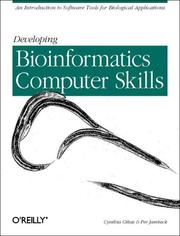
ISBN: 1565926641 9781565926646 Year: 2001 Publisher: Beijing : Cambridge : O'Reilly,
Abstract | Keywords | Export | Availability | Bookmark
 Loading...
Loading...Choose an application
- Reference Manager
- EndNote
- RefWorks (Direct export to RefWorks)
Programming --- Computational Biology --- Bioinformatics --- Bio-informatique --- Bioinformatics. --- Computational Biology. --- Bioinformatica --- Bioinformatica. --- Bio-informatics --- Biological informatics --- Biology --- Information science --- Computational biology --- Systems biology --- Data processing --- Bioinformatique. --- Bioinformatique
Book
ISBN: 9780123859440 0123859441 012810046X 1784023809 012385945X 1283740389 Year: 2012 Publisher: Amsterdam Boston Elsever/Academic Press
Abstract | Keywords | Export | Availability | Bookmark
 Loading...
Loading...Choose an application
- Reference Manager
- EndNote
- RefWorks (Direct export to RefWorks)
This book provides an entry point into Systems Biology for researchers in genetics, molecular biology, cell biology, microbiology and biomedical science to understand the key concepts to expanding their work. Chapters organized around broader themes of Organelles and Organisms, Systems Properties of Biological Processes, Cellular Networks, and Systems Biology and Disease discuss the development of concepts, the current applications, and the future prospects. Emphasis is placed on concepts and insights into the multi-disciplinary nature of the field as well as the importance of systems biolo
Systems biology --- Bioinformatics --- Bio-informatics --- Biological informatics --- Biology --- Information science --- Computational biology --- Biological systems --- Molecular biology --- Data processing
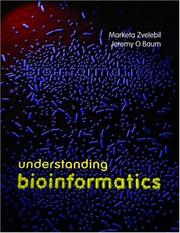
ISBN: 9780815340249 0815340249 Year: 2008 Publisher: New York (N.Y.) Garland Science
Abstract | Keywords | Export | Availability | Bookmark
 Loading...
Loading...Choose an application
- Reference Manager
- EndNote
- RefWorks (Direct export to RefWorks)
Suitable for advanced undergraduates and postgraduates, "Understanding Bioinformatics" provides a definitive guide to this vibrant and evolving discipline. This book takes a conceptual approach. It guides the reader from first principles through to an understanding of the computational techniques and the key algorithms. "Understanding Bioinformatics" is an invaluable companion for students from their first encounter with the subject through to more advanced studies. This book is divided into seven parts, with the opening part introducing the basics of nucleic acids, proteins and databases. Subsequent parts are divided into 'Applications' and 'Theory' Chapters, allowing readers to focus their attention effectively.In each section, the Applications Chapter provides a fast and straightforward route to understanding the main concepts and 'getting started'. Each of these is then followed by Theory Chapters which give greater detail and present the underlying mathematics. In Part 2, Sequence Alignments, the Applications Chapter shows the reader how to get started on producing and analyzing sequence alignments, and using sequences for database searching, while the next two chapters look closely at the more advanced techniques and the mathematical algorithms involved. The Part 3 covers evolutionary processes and shows how bioinformatics can be used to help build phylogenetic trees. Part 4 looks at the characteristics of whole genomes. In Parts 5 and 6 the focus turns to secondary and tertiary structure - predicting structural conformation and analysing structure-function relationships. The last part surveys methods of analyzing data from a set of genes or proteins of an organism and is rounded off with an overview of systems biology.The writing style of "Understanding Bioinformatics" is notable for its clarity, while the extensive, full-color artwork has been designed to present the key concepts with simplicity and consistency. Each chapter uses mind-maps and flow diagrams to Give an overview of the conceptual links within each topic.
Biomathematics. Biometry. Biostatistics --- Computational Biology --- Bioinformatics --- Bio-informatique --- methods --- Bioinformatics. --- methods. --- Bioinformatica --- 57.087 --- Methods and techniques for parameter estimation. Recording of biological data --- Bioinformatica. --- 57.087 Methods and techniques for parameter estimation. Recording of biological data --- Methods. --- Bio-informatics --- Biological informatics --- Biology --- Information science --- Computational biology --- Systems biology --- Data processing
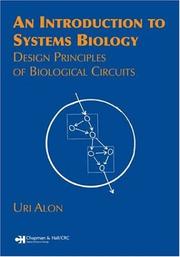
ISBN: 1584886420 9781584886426 Year: 2007 Volume: 10 Publisher: Boca Raton (Fla.) : Chapman & Hall/CRC,
Abstract | Keywords | Export | Availability | Bookmark
 Loading...
Loading...Choose an application
- Reference Manager
- EndNote
- RefWorks (Direct export to RefWorks)
An Introduction to Systems Biology: Design Principles of Biological Circuits builds a solid foundation for the intuitive understanding of general principles. It encourages the reader to ask why a system is designed in a particular way and then proceeds to answer with simplified models. Explains the basic circuitry in transcription regulation, signal transduction, and developmental networks Includes examples ranging from bacterial chemotaxis through developmental patterning and neuronal circuits to immune recognition Examines the principle of robustness Details how constrained evolutionary optimization can be used to understand optimal circuit design Considers how kinetic proofreading and other mechanisms can minimize errors made in biological information-processing Includes solved problems after each chapter that detail topics not discussed in the main text Thorough and accessible, this book presents the design principles of biological systems, and highlights the recurring circuit elements that make up biological networks. It provides a simple mathematical framework which can be used to understand and even design biological circuits. The text avoids specialist terms, focusing instead on several well-studied biological systems that concisely demonstrate key principles.
Biomathematics. Biometry. Biostatistics --- Mathematical statistics --- Computational biology --- Biological systems --- Bio-informatique --- Systèmes biologiques --- Mathematical models --- Modèles mathématiques --- Systems biology --- Cellule --- cells --- Biologie --- biology --- Développement biologique --- biological development --- Réseau de neurones --- Neural networks --- Mécanisme chimiotactique --- Chemotaxis --- Facteur de transcription --- Transcription factors --- Immunogénétique --- Immunogenetics --- Expression des gènes --- gene expression --- Biosystems --- Systems, Biological --- Biology --- System theory --- Philosophy --- Computational biology. --- Systems biology. --- Basic Sciences. Biology --- Mathematical models. --- Biosystematics --- Biosystematics. --- Systèmes biologiques --- Modèles mathématiques --- Bioinformatics --- Molecular biology --- Biological systems - Mathematical models
Book
ISBN: 9781118581780 1118581784 Year: 2015 Publisher: Chichester, West Sussex, UK ; Hoboken, New Jersey : John Wiley and Sons, Inc.,
Abstract | Keywords | Export | Availability | Bookmark
 Loading...
Loading...Choose an application
- Reference Manager
- EndNote
- RefWorks (Direct export to RefWorks)
Bioinformatics and Functional Genomics provides a broad-based introduction to bioinformatics by following three real-world examples throughout the book: retinol-binding protein, breast cancer, and a calcium binding site C2. The author emphasizes the use of computational tools and databases to study connections between the structure of proteins and genes to function, development, evolution, and disease. Readers learn real skills, such as how to analyze genes and proteins, how to make trees using phylogenetic software, how to extract data, and how to identify genes and proteins implicated in diseases.
Bioinformatica. --- Basic Sciences. Bioinformatics -- Bioinformatics (General). --- Basic Sciences. Bioinformatics -- Proteomics. --- Bioinformatics --- Genomics --- Molecular biology --- Computational Biology --- Genetic Techniques --- Proteomics --- Genetic Technic --- Genetic Technics --- Genetic Technique --- Technic, Genetic --- Technics, Genetic --- Technique, Genetic --- Techniques, Genetic --- Genetics --- Genetic Counseling --- Genetic Phenomena --- Human Genome Project --- Genome --- Molecular biochemistry --- Molecular biophysics --- Biochemistry --- Biophysics --- Biomolecules --- Systems biology --- Genome research --- Genomes --- Molecular genetics --- Bio-informatics --- Biological informatics --- Biology --- Information science --- Computational biology --- Data processing --- methods --- Research --- Genetic Techniques. --- Comparative Genomics --- Comparative Genomic --- Genomic, Comparative --- Genomics, Comparative --- Genomics. --- Proteomics. --- Bioinformatics. --- Génomique. --- Bioinformatique. --- Protéomique. --- Génomique. --- Bioinformatique --- Protéomique.
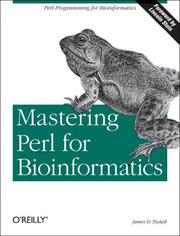
ISBN: 0596003072 Year: 2003 Publisher: Paris : O'Reilly,
Abstract | Keywords | Export | Availability | Bookmark
 Loading...
Loading...Choose an application
- Reference Manager
- EndNote
- RefWorks (Direct export to RefWorks)
Perl (Langage de programmation) --- Bioinformatica --- Bioinformatica. --- Programming --- Bioinformatics. --- Perl (Computer program language). --- Bioinformatics --- Perl (Computer program language) --- Pathologically Eclectic Rubbish Lister (Computer program language) --- Practical Extraction and Report Language (Computer program language) --- Scripting languages (Computer science) --- Bio-informatics --- Biological informatics --- Biology --- Information science --- Computational biology --- Systems biology --- Data processing --- Bio-informatique
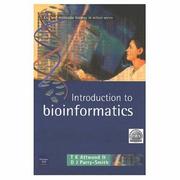
ISBN: 0582327881 9780582327887 Year: 1999 Publisher: Harlow, Essex, England Longman
Abstract | Keywords | Export | Availability | Bookmark
 Loading...
Loading...Choose an application
- Reference Manager
- EndNote
- RefWorks (Direct export to RefWorks)
The book provides an undergraduate (final year) introduction to bioinformatics focussing on two key areas, genomics and protein sequence analysis. It provides an overview of primary, composite and secondary databases, and gives a brief introduction to the Internet and the world wide web.
Molecular biology --- Computer. Automation --- Bioinformatics --- Bio-informatique --- Biologie moléculaire --- Data processing --- Informatique --- Gene mapping --- Data processing. --- Biologie moléculaire --- Basic Sciences. Bioinformatics -- Bioinformatics (General) --- ALLW. --- 57.087 --- 57.087 Methods and techniques for parameter estimation. Recording of biological data --- Methods and techniques for parameter estimation. Recording of biological data --- Molecular biochemistry --- Molecular biophysics --- Biochemistry --- Biophysics --- Biomolecules --- Systems biology --- Molecular biology - Data processing. --- Gene mapping - Data processing. --- Basic Sciences. Bioinformatics -- Bioinformatics (General). --- Computational Biology
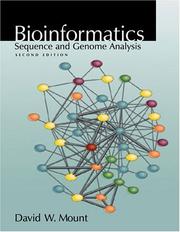
ISBN: 0879697121 9780879697129 9780879696870 0879696877 Year: 2004 Publisher: New York (N.Y.): Cold Spring Harbor laboratory press
Abstract | Keywords | Export | Availability | Bookmark
 Loading...
Loading...Choose an application
- Reference Manager
- EndNote
- RefWorks (Direct export to RefWorks)
DNA sequences --- bio-informatica --- biochemie --- biologie --- data acquisitie --- genoom --- informatietechnologie --- internet --- moleculaire biologie --- populatiegenetica --- proteïnen --- statistiek --- websites --- Séquence des acides aminés --- Nucleotide sequence. --- Bioinformatica --- Bioinformatica. --- Séquence nucléotidique --- Séquence des acides aminés --- Amino acid sequence --- Bioinformatics --- Genetics --- Nucleotide sequence --- 575.113 --- 575.113 Gene. Genetic apparatus. Genome --- Gene. Genetic apparatus. Genome --- Analysis, Nucleic acid sequence --- Analysis, Nucleotide sequence --- Base sequence (Nucleic acids) --- DNA sequence --- Nucleic acid sequence analysis --- Nucleotide sequence analysis --- RNA sequence --- Sequence, Nucleotide --- Nucleic acids --- Nucleotides --- Sequence alignment (Bioinformatics) --- Biology --- Embryology --- Mendel's law --- Adaptation (Biology) --- Breeding --- Chromosomes --- Heredity --- Mutation (Biology) --- Variation (Biology) --- Bio-informatics --- Biological informatics --- Information science --- Computational biology --- Systems biology --- Amino acid sequence analysis --- Analysis, Amino acid sequence --- Peptide sequence --- Peptide sequencing --- Protein sequence --- Protein sequencing --- Sequence, Amino acid --- Amino acids --- Proteins --- Data processing --- Analysis --- Molecular biology --- Amino acid sequence. --- Bioinformatics. --- Data processing. --- Génétique --- Bio-informatique --- Informatique --- Génétique --- Bioinformatique --- Séquence nucléotidique --- Computational biology. --- Genetic Phenomena. --- Genetic Techniques. --- Genetics - Data processing --- Genetic Phenomena --- Genetic Techniques --- Base sequence --- Microship analytical procedures --- Phylogeny --- Sequence analysis
Book
ISBN: 9781541644632 1541644638 9781541644649 Year: 2019 Publisher: New York, N.Y. Basic Books
Abstract | Keywords | Export | Availability | Bookmark
 Loading...
Loading...Choose an application
- Reference Manager
- EndNote
- RefWorks (Direct export to RefWorks)
A visit to a physician these days is cold: physicians spend most of their time typing at computers, making minimal eye contact. Appointments generally last only a few minutes, with scarce time for the doctor to connect to a patient's story, or explain how and why different procedures and treatments might be undertaken. As a result, errors abound: indeed, misdiagnosis is the fourth-leading cause of death in the United States, trailing only heart disease, cancer, and stroke. This is because, despite having access to more resources than ever, doctors are vulnerable not just to the economic demand to see more patients, but to distraction, burnout, data overload, and their own intrinsic biases. Physicians are simply overmatched. As Eric Topol argues in Deep Medicine, artificial intelligence can help. Natural-language processing could automatically record notes from our doctor visits; virtual psychiatrists could better predict the risk of suicide or other mental health issues for vulnerable patients; deep-learning software will make every physician a master diagnostician; and we could even use smartphone apps to take our own medical selfies for skin exams and receive immediate analysis. . On top of that, the virtual smartphone assistants of today--Alexa, Siri, Cortana--could analyze our daily health data to reduce the need for doctor visits and trips to the emergency room, and support for people suffering from asthma, epilepsy, and heart disease. By integrating tools like these into their daily medical practice, doctors would be able to spend less time collecting and cataloging information, and more time providing thorough, intimate, and meaningful care for their patients, as no machine can. Artificial intelligence can also help remedy the debilitating cost of healthcare, both for individuals and the economy writ large. The medical sector now absorbs 20 percent of the US gross domestic product--it is largest sector by dollars and jobs. And it's very inefficient. Take the cost of medical scans: There are over 20 million medical scans performed in the US every day, and an MRI, for example, costs hundreds to thousands of dollars. AI could process 260 million medical scans (more than 2 weeks' worth) in less than 24 hours for a cost of only $1000. We pay billions and billions of dollars for the same work today. The American health care system needs a serious reboot, and artificial intelligence is just the thing to press the restart button. As innovative as it is hopeful, Deep Medicine ultimately shows us how we can leverage artificial intelligence for better care at lower costs with more empathy, for the benefit of patients and physicians alike.
Artificial Intelligence. --- Diagnosis, Computer-Assisted. --- Medical Informatics. --- Quality Improvement. --- Therapy, Computer-Assisted. --- Artificial intelligence --- Medical informatics --- Diagnosis --- Artificial Intelligence --- Medical Informatics --- Diagnosis, Computer-Assisted --- Therapy, Computer-Assisted --- Quality Improvement --- Improvement, Quality --- Improvements, Quality --- Quality Improvements --- Computer-Assisted Protocol-Directed Therapy --- Therapy, Computer-Assisted Protocol-Directed --- Computer-Assisted Therapy --- Protocol-Directed Therapy, Computer-Assisted --- Computer Assisted Protocol Directed Therapy --- Computer Assisted Therapy --- Computer-Assisted Protocol-Directed Therapies --- Computer-Assisted Therapies --- Protocol Directed Therapy, Computer Assisted --- Protocol-Directed Therapies, Computer-Assisted --- Therapies, Computer-Assisted --- Therapies, Computer-Assisted Protocol-Directed --- Therapy, Computer Assisted --- Therapy, Computer Assisted Protocol Directed --- Computer-Assisted Diagnosis --- Computer Assisted Diagnosis --- Computer-Assisted Diagnoses --- Diagnoses, Computer-Assisted --- Diagnosis, Computer Assisted --- Computer Science, Medical --- Health Informatics --- Health Information Technology --- Informatics, Clinical --- Informatics, Medical --- Information Science, Medical --- Clinical Informatics --- Medical Computer Science --- Medical Information Science --- Health Information Technologies --- Informatics, Health --- Information Technology, Health --- Medical Computer Sciences --- Medical Information Sciences --- Science, Medical Computer --- Technology, Health Information --- Computational Biology --- Biomedical Technology --- American Recovery and Reinvestment Act --- Computational Intelligence --- AI (Artificial Intelligence) --- Computer Reasoning --- Computer Vision Systems --- Knowledge Acquisition (Computer) --- Knowledge Representation (Computer) --- Machine Intelligence --- Acquisition, Knowledge (Computer) --- Computer Vision System --- Intelligence, Artificial --- Intelligence, Computational --- Intelligence, Machine --- Knowledge Representations (Computer) --- Reasoning, Computer --- Representation, Knowledge (Computer) --- System, Computer Vision --- Systems, Computer Vision --- Vision System, Computer --- Vision Systems, Computer --- Heuristics --- Data processing --- #SBIB:316.334.3M51 --- #SBIB:316.334.3M30 --- Organisatie van de gezondheidszorg: modellen van therapeutisch handelen --- Medische sociologie: gezondheidsgedrag --- Medical informatics. --- Gesundheitstelematik. --- Gesundheitsinformationssystem. --- Medizinische Informatik. --- Künstliche Intelligenz. --- Artificial intelligence. --- Medical applications. --- Data processing. --- Clinical informatics --- Health informatics --- Medical information science --- Information science --- Medicine --- AI (Artificial intelligence) --- Artificial thinking --- Electronic brains --- Intellectronics --- Intelligent machines --- Machine intelligence --- Thinking, Artificial --- Bionics --- Cognitive science --- Digital computer simulation --- Electronic data processing --- Logic machines --- Machine theory --- Self-organizing systems --- Simulation methods --- Fifth generation computers --- Neural computers --- Surgery, Computer-Assisted --- Hygiene. Public health. Protection --- Human medicine --- Artificial intelligence. Robotics. Simulation. Graphics --- medische technologie --- medische informatica --- bescherming --- gezondheidszorg --- hygiëne
| Listing 1 - 9 of 9 |
Sort by
|

 Search
Search Feedback
Feedback About UniCat
About UniCat  Help
Help News
News